 Taxidermy supplies and tips
Taxidermy supplies and tipsLearning taxidermy
History of taxidermy
Bird taxidermy
Coyote taxidermy
Deer taxidermy
Fish taxidermy
Skinning fish
Mount fish skin<
Skinning turtle
Mount turtle
Mounting lizard
Mounting crawfish
Muskrat taxidermy
Squirrel taxidermy
Taxidermy panels and shields
Making animal fur rugs
Taxidermist hunting
Taxidermy mounting kits
Other resources
Mount fish skin
If the specimen is opened on the side for panel mounting and we wish to follow a very simple method in mounting, one that is quite as practical as it is simple, we must take a different step than outline sketches before skinning. This is to make a complete body and head cast of the best side in plaster of paris. This does not include the fins. To make the cast neatly, lay the fish, best side up, in a slight hollow in a box of clean, damp sand. Pack the sand up under the fish body smoothly so that more than half of him rises in cameo style from the smooth surface.
Make up enough plaster to do the cast at once. To mix plaster properly, sprinkle it into the dish of water until a little will begin to stand out dry above the surface. Then with a spoon sunk deep in it, gently stir to evenness. It is then ready to pour. Before doing this, jar the pan upon the table a time or two to
cause any possible bubbles to rise.
Pour evenly over the fish, or better still, dip it on with the spoon. The plaster should be thick enough to barely flow for making a proper cast.
The pectoral fins are simply laid flat to the side in making the cast.
Allow the cast to set hard before lifting it and removing the fish. Trim off the overlapping edge so that no undercut remains.
The cleaned and poisoned skin should lay in damp cloth over one night and is then laid in accurate place back in the cast. Pour it nearly full of medium thick plaster of paris, carefully mixed free of bubbles.
Settle a board, cut to approximate body outline but much smaller, into the unset plaster and press the flap edges of the skin back together over the board, molding edge of back and belly to round back away from trimmed edge of mold. This must be all done with accuracy before the plaster sets, but you will find it gives enough time. Do not work in a strung-up, nervous way.
When the plaster is set hard, remove fish from mold, hold it upon palm of left hand and tack edges of skin to back-board. (For gen-
eral details of this method see Fig. 21).
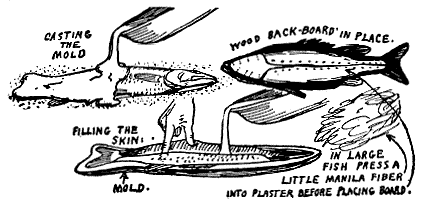
Screw the specimen to a piece of board and adjust fins, carding them over little blocks and holding the cards with sharp toilet pins until drying is completed.
See that the jaws set right. They should have gone into the mold in proper relation to each other. Dig out the plaster in eye socket
on show side and set eye in a little fresh plaster.
A simple method of making a modelled mannikin for fish follows:
Have the freshly skinned body or sketches of same at hand. Cut a soft-wood board core, making it some smaller than outline of carcass.
Anchor into this two rigid supporting wires or rods as shown in Fig. 22.
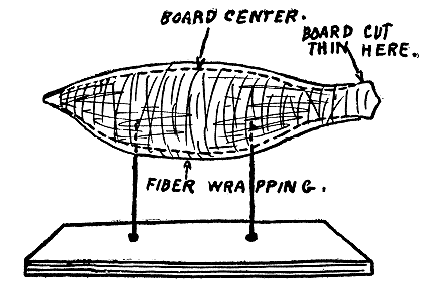
Upon this boardcore wrap strongly and smoothly with thread or small cord a quantity of manila fiber to same shape of body but one-half to three-quarters inch smaller than the body. Over this apply plaster of paris and manila fiber (dipping the fiber and laying it on) to approximate size of natural body. When this is set hard, pare it smoothly into outlines of natural shape and gouge out slight grooves for fin bases to set into: See Fig. 23-)
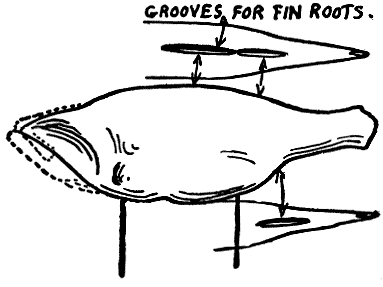
Mannikins of this type should be dried out as quickly as possible and shellaced before applying the skin. Apply the fish skin with a
paste of compo. No. I. Card the fins as in
Fig 24.
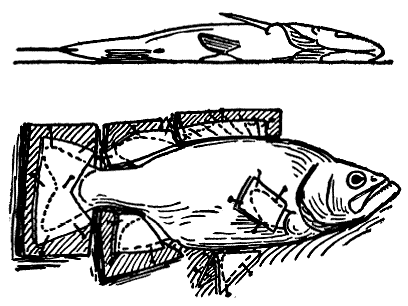
Fill the face through mouth and eyes withplaster of paris with a little chopped manila fiber worked into it. Use a slight amount of
glue in the water to prevent rapid setting of the plaster. Hold face in place until set, with light wrapping of soft cord, using care that it does not crease soft parts.
Special fish eyes may be procured at any dealers in taxidermist supplies. As the last detail of mounting, set the eyes. In all kinds
of specimens use a size of eyes that pass through the lids easily without the need of stretching to admit them. A panel-fish needs
but one eye as a rule.
When the specimen is dry apply a coat of thin shellac as a filler to the surface to paint upon. This filler should be very thin and leave
only a suggestion of gloss.
Use oil colors and apply as little pigment as may be used for the effect. Kerosene oil is an ideal thinning medium for tube oil colors. Have very little paint upon the brush when applying the tints to a fish or reptile skin.
A suggestion of natural hues and markings will be found more satisfactory than painting them on heavily. In a day or two when the
paint is dry apply a very thin coat of alcohol-cut picture varnish. Turps-cut varnish is liable to loosen the paint, thus necessitating entire refinishing. Fasten a panel fish to the setting that is to frame him, with two screws at least, countersinking their heads in the panel back.
The fish piece may be hung as a picture, with screw eyes and cord or it may be hung with one or two sheet metal slots countersunk
into the panel back. This will allow the piece to be applied flat to any wall that will hold screws.
Large fishes mounted with rods for pedestal setting should have rods threaded at both ends for nuts. Upper ends that support core board
should be bent as shown in Fig. 25.
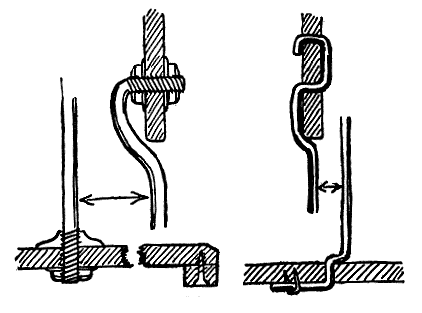
This figure also shows complete method of setting both rod and wire supports in body core and permanent stand.

